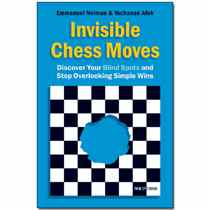Invisible Chess Moves
Emmanuel Neiman, Yochanan Afek

Invisible Chess Moves by Emmanuel Neiman and Yochanan Afek is an original work dedicated to helping chess players improve their ability to eliminate blind spots when selecting moves.
As the authors show, even very strong players can overlook “simple moves. Consider the following game where French 2700 GM Etienne Bacrot is lost after 5 moves!
Bacrot – Relange, France 2006, 1.e4 c5 2.Ne2 d6 3.g3 d5!? 4.Nc3?! d4 5.Nd5? g5! 6.d3 h6! 7.Bg2 e6 and Black quickly won.
A glance at the table of contents shows this is a unique book that presents material rarely covered.
Part I Objective Invisibility 21
Chapter 1 Hard-to-see moves 22
A: Quiet moves 23
B: Intermediate moves 27
The desperado 31
C: Alignment 36
D: For getting the rules 53
E: Quiet positions 57
Chapter 2 Geometrically invisible moves 71
A: Horizontal effect 72
B: Circuit 74
Rook circuit 74
Bishop circuit 75
Queen circuit 75
C: Changing wings 77
D: Backward moves 83
E: Back ward knight moves 86
F: Pin and self-pin 89
G: Geometrical moves 96
Part II Subjective Invisibility 111
Chapter 3 Invisible moves for positional reasons 112
A: Pawn structures 113
B: Weakening of the kings defences 118
C: Unexpected exchanges 123
D: Unusual position of a piece 126
E: Anti-developing moves 133
F: Residual image 135
Chapter 4 Invisible moves for psychological reasons 151
A: Anticipation of the probable result 152
B: Blunders in World Championship matches 163
C: Forward moves in defence 167
D: Backward attacking moves 176
Test 191
Test solutions 205
Explanation of Symbols 237
Index of Players 238
Plenty of instructive exercises and positions to solve make Invisible Chess Moves an interesting book for players from 1800 on up.
Highly Recommended
